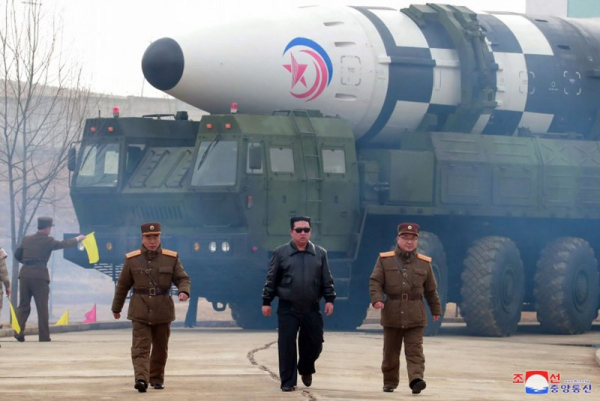

North Korea has a secret long-range missile base near the Chinese border, a report from the Washington-based Center for Strategic and International Studies revealed Wednesday. In this 2022 photo, North Korean leader Kim Jong Un walks in front of a nuclear-capable ICBM. File Photo by KCNA/UPI | License Photo
North Korea has constructed a secret military base near the Chinese border to hold intercontinental ballistic missiles that pose a “potential nuclear threat” to the United States, a report by the Washington-based Center for Strategic and International Studies said.
Beyond Parallel, a Korea-focused project of CSIS, revealed the Sinpung-dong Missile Operating Base in North Pyongan Province on Wednesday, based on an analysis of commercial satellite imagery. The North has never declared its existence.
The fortified underground base is located around 17 miles from the Chinese border in Taegwan County, the think tank said in a report posted on its website.
It likely houses a brigade-sized unit with a total of six to nine nuclear-capable ICBMs and their mobile launchers, CSIS analysts said.
“These missiles pose a potential nuclear threat to East Asia and the continental United States,” the report warned.
The base is situated in a narrow mountain valley and measures over 5,400 acres — more than six times larger than New York’s Central Park.
It is unclear what types of missiles are being stored at the base, but the report’s authors believe the arsenal includes nuclear-capable Hwasong-15 or Hwasong-18 ICBMs, or an as-yet unknown ICBM.
Both the liquid-fuel Hwasong-15 and solid-fuel Hwasong-18 missiles are thought to be capable of reaching the continental United States. Missiles using solid-fuel propellants can be transported and launched more quickly than liquid-fuel models.
“During times of crisis or war, these launchers and missiles will exit the base, meet special warhead storage/transportation units, and conduct launch operations from dispersed pre-surveyed sites,” the report said.
Construction on the base began around 2004, according to satellite images, and it has been operational since 2014.
It is part of a strategic “missile belt” of multiple bases, the report said, comprising a key component of Pyongyang’s “evolving ballistic missile strategy, and its expanding strategic-level nuclear deterrence and strike capabilities.”
The report comes days after North Korean leader Kim Jong Un called for the country’s “rapid expansion of nuclearization.”
The North passed a law declaring itself a nuclear-armed state in 2022. Kim called the decision “irreversible” and later amended the country’s constitution to enshrine the permanent growth of Pyongyang’s nuclear arsenal.
While U.S. President Donald Trump has suggested he would likely resume one-on-one nuclear negotiations with Kim, North Korea last month dismissed the notion of denuclearization talks.
“Any attempt to deny the position of the DPRK as a nuclear weapons state … will be thoroughly rejected,” Kim Yo Jong, the sister of the North Korean leader, said in a statement.
The Democratic People’s Republic of Korea is the official name of North Korea.
In a June report, the Stockholm International Peace Research Institute estimated that North Korea currently possesses about 50 nuclear warheads and has enough fissile material for 40 more.